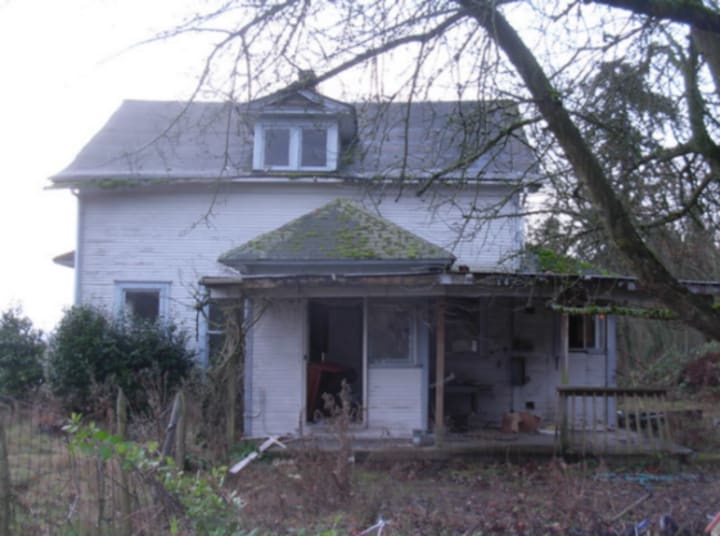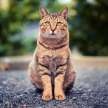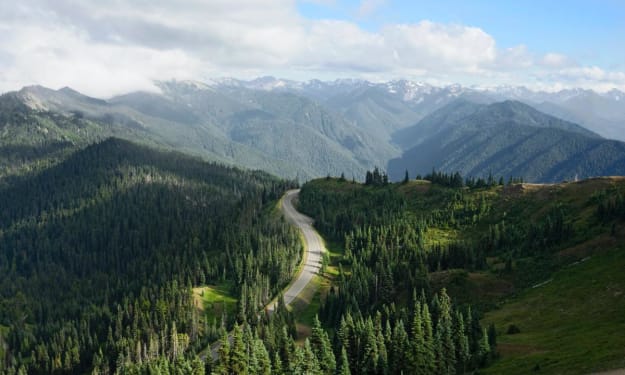How to Write Poetry Based on Pictures
Strategies and Examples

A gray house in a field. An image that expresses loneliness and age. | Source: Pxfuel
Writing Poetry Based on Photographs
I’ve been doing writing prompts, lessons, and poems about a city I can’t visit—Walla Walla, Washington. I find focusing on one city makes it easier for people who read my articles to follow along.
Today’s lesson will cover how to write poetry based on pictures. This is really easy and convenient to do. You can find pictures on the Internet or in books and magazines. Perhaps you have some old pictures in a storage bin that could be your muse.
My poetry examples at the end will be from abandoned farmhouses in Washington state. I tried to narrow my search to Walla Walla, but it made things too challenging.
Finding Free Images
Some search sites you can use are Google Images, Flickr, Pexels, Pixabay, Pxfuel, Wiki Commons, and Unsplash. The public domain has a plethora of resources you can use for free.
To find free-to-use pictures on Google Images, hit “Tools” then “Usage Rights” and select “creative commons licenses.” Make sure to read copyright agreements for any pictures you consider using.
Essential Poetry Writing Strategies
The following are my top tips for writing poems based on pictures:
- When writing poems about pictures, you want to focus on descriptive language. Paint the picture in words for your reader. Focus on the details of the picture that stand out. Ask yourself what made you stop to look at the picture in the first place.
- When it comes to descriptive language, you want to focus on the five senses. Consider what you could sense if you were in the picture: what you’d see, hear, taste, touch, and smell.
- When looking at a picture, you want to think of it as an art piece. Some of the most important features to consider are color, depth, form, line, shape, size, and texture.
- You may want to ask yourself what kind of people would go along with the picture. Poems are not really for developing a full-on story with detailed characterization and plot. You only get whisps of character because poems for the most part are about brevity, a snapshot, or a mood. It’s fairly uncommon now to write epic poems like The Odyssey, and we could argue that because of its length and storytelling that it’s prose with poetic language, but that’s a lesson to go into for another day… the differences between prose and poetry and when they overlap.
- Adding characters to your poems can help ground your piece. It’s easier for people to understand characters and their motivations than ambiguous concepts.
- When you find a picture, look for any descriptions that might come in handy. Captions, dates, and historical references can be really helpful when trying to peg your poem and its setting. It’s wise to look for articles that might pertain to the picture.
- If a picture isn’t inspiring any visceral language, move on to something else. Some pictures don’t have striking features.
- What is the date of the picture? What kind of things happened during that time?
Additional Poetry Writing Strategies
Listening to music that fits with the style of your pictures can be helpful. While looking at pictures of abandoned farmhouses in Washington, I listened to Feist, Johnny Cash, Cat Power, and Emily Haines & The Soft Skeleton.
Try different strategies when it comes to writing poetry based on pictures. You may want to meditate and consider how you want to build the poem. Some people write better with intentional plans and strategies, others prefer to sit down and write off the top of their head. There is no right or wrong answer, just do what helps you to get writing.
One strategy I like to use is to time myself. I’ll spend 2–5 minutes writing as much as I possibly can without any reservations. Whatever I want to write, I throw it down. Don’t stop to edit what you’re writing until the timer has ended. The spelling errors and obvious grammar issues may annoy you but leave them there until the timer has stopped. Focus first on writing and giving yourself a raw draft that you can polish later.
Sometimes I’ll pick an exact format for my poem and/or try to use a particular rhyme scheme or meter. Sonnets can be lovely, villanelles are tricky, and haikus require precision. For a successful haiku, you need to go beyond the syllable pattern, you should strive to make it something meaningful that grabs people.
Photography Terminology
When it comes to writing about pictures, it will help if you know some of the techniques photographers use to create their art.
Here are some terms that might help you in describing your photograph:
Saturation: One of the most important and noticeable aspects of a picture is how much saturation it has. Black-and-white pictures have no saturation, meaning all the color has been stripped away. Sometimes you might have a picture that has no saturation except for one color. Oversaturation means the colors are bleeding over, and they’re overly bright. Increasing saturation makes the picture look more vivid. Decreasing saturation makes the colors look more muted.
Luminance: The amount of light emitted from, passing through, or reflecting off a subject.
Focus/Blurry: Consider whether the picture has blurry spots or great focus and clarity. Does the picture seem to really focus on a particular spot? Polaroids tend to be washed out. 4K pictures are going to look splendid with high resolution, rich colors, and precise focus. Technology changes, so you should notice differences in photography from the 1960s to now.
Head Room: This has to do with how much space the subjects in the picture have above their heads. A picture that has a lot of head room is perfect for adding font. Sometimes photographers will do something artsy where they crop out a person’s head and focus on the legs or feet. Head room essentially addresses the vertical position of the subject within the frame.
Depth of Field: The distance between the closest and furthest objects that are in focus. A deep depth of field is when very faraway objects are still in focus.
Overexposure or Underexposure: This has to do with how much light is coming into the camera sensor. Overexposed pictures have too much light and look washed or blown out, giving them a pale look. Underexposed pictures look dim and dark and the colors are flat.
Chromatic Aberration: This causes pictures to have purple fringing. It’s an odd effect when the lens struggles to bring the wavelengths of the colors into their correct hue. This is usually found in older and lower-quality photography. It is similar to a glitch effect, when colors distort or separate.
Bokeh: An intentional background blur. This is popular in portrait pictures, essentially pictures of people. Bokeh is the Japanese word for haze or blur.
Vignetting: Reducing an image’s brightness around the border to intentionally draw the eyes to a brighter section of the photograph. It can make a picture look like it is being viewed through a telescope or hole.
Golden Hour: The period right after sunrise and before sunset. It is also called the magic hour. The sun is low on the horizon, so light takes on a redder hue as opposed to when the sun is higher in the sky.
Noise: There is visual distortion in the picture that looks like dots or specs. This can cause the picture to look messy or unclear.
Example Poems

Abandoned farm in Washington, Klickitat County. The photo was taken in 1939. | Source: Public Domain Media, New York Public Library
Near the End of the Great Depression
Gray isolated spaces where love struggles
to preach her song — those plains and dreams
as stagnate as the cloudless sky. Hints
of a better tomorrow — hints
of a shorter sorrow — stagnate,
out of reach.
—
The preacher-man gives away his clothes,
he offers his flask to dry lips,
he visits poor folk
locked
into limbo.
Living behind iron bars,
can’t leave,
dust in the lungs.
—
Electricity lines
stretching across the field, a reminder
that we’re all connected, energy
and topography unbroken for miles and miles
even into
faded memories, dust-covered siding,
rolling tumbleweed, hanging laundry,
and red barns with sliding doors.
There are no animals to tend
because the farmer can’t afford.

Abandoned Farm House and Flower Stand, Kent Washington | Source: Flickr, Brewbooks
Abandoned Farmhouse on Orillia Road
I went on a walk into the fields,
I hiked the dusty roads, my old
stomping grounds. I stumbled upon
a farmhouse I used to know.
It’s abandoned, the front door off the hinges,
vines crawling on the roof, and worn-out siding.
The house, she sits at the end
of Orillia Road in Kent, Washington.
—
Years ago, the owners sold flowers;
they grew them in their yard.
The couple no longer live there,
the lot set to be leveled
for apartments and condos.
—
All these old charms set to vanish
as the new stewards of the land
come to settle. The changing
of the guard, say farewell,
say farewell,
say farewell to your corner
of the earth.

Date: October 2008. An abandoned house near Chesaw, Washington. | Source: Wiki Commons, A. Balet
Forgotten House between Trees with Golden Leaves
Tall grass, pale blue sky, and white trees
with bright golden leaves. Those leaves
pop with color, the most stunning feature
in the rustic-scape.
—
A two-story farmhouse with no windows
and no doors. Just the frames cut
into the sides of the exterior.
The frames, like portals inviting
the traveler to explore the halls
and rooms and secrets within.
—
An abandoned house near Chesaw
with no lore, no hint of its past owners.
A two-story house for a family,
a preacher, a hermit,
who knows.
—
The house blends into the scenery;
its colors merging with the fields and sky.
—
I’ve become obsessed with this house
and the way it sinks into the background:
I think it wants to be sucked into the earth.
—
Some windows boarded or partially boarded.
The dark contrast of the open window frames,
it draws your eyes to the house,
a simple home
in a beige field.
—
The brown two-story house seeks to be quiet,
forgotten, unimportant, at the end of a meditation.

Abandoned building on campus of Northern State Hospital in Cedro-Wooley, WA. It was used as a farm for mentally disturbed patients. | Source: Public Domain Media, Library of Congress
Additional Information about North State Hospital
The image of the North State Hospital and the caption I found with it left me with a lot of questions. I looked up this place on Google and read about its seemingly forgotten history. I used an article from The Seattle Times to learn about the place. My poem for the property is sad; it is very different from the other ones I featured for this poetry lesson.
The article from The Seattle Times is “An old mental institution, and its cemetery, might get a dignified makeover”. It was written by Ron Judd, a Pacific NW magazine writer.
Farm for Harmless Patients
A rural refuge, the Farm for Harmless Patients.
The compound took in the disturbed.
The hollow buildings abandoned,
they’re the ghostly reminders
of troubled lives. Tens of thousands of them
dropped off at the secluded rural enclave—
family wanting nothing to do with them.
Abandoned with a court order.
—
The ruins rest at Hansen Creek, a tributary
of the lower Skagit River
in the foothills
of the North Cascades.
—
As many as 2,700 souls would stay
at the Farm for Harmless Patients.
It included cottages, ward buildings,
barns, cattle, surgical rooms,
and a mass grave.
—
Barbaric treatments performed
from electric shock
to transorbital lobotomy.
—
This was how we treated epileptics,
alcoholics, drug addicts, people
with acute nonconformity,
menopausal women, and immigrants.
Heavy sedation, insulin coma therapy,
and experimental drugs.
—
It might surprise you to find
the Farm for Harmless Patients was considered
to have a good moral compass
with more compassion and care
than similar facilities.
—
But many went in
and never came out.
—
The semi-mothballed remains tempt
amateur ghost hunters and horror filmmakers —
chronicles of ghost towns
and forgotten history.
The red-tiled roofs embedded
with algae, cracked single-pane windows,
crawling vines, aged paint
breaking in flakes.
—
Come tour its dark, dank halls,
consider the stark activity
that once hailed in its corridors.
A gurney with a patient,
a lonely soul looking out the window,
unchanged bedsheets,
a table underneath a surgical floodlight,
thick glass separating a viewing area
for spectators, for voyeurs, for hyprocrites.
—
Thousands died, and more often
then not
no family member
would come
to claim
the deceased.
—
Bodies cremated
and left in tin food cans.
Names etched on makeshift urns.
—
The remains were moved one day
and laid to rest in a mass grave.
—
Some patients were buried
in the compound’s cemetery.
The grassy field where they lay
is notoriously swampy, a thick thatch.
Stones were placed in crudely made coffins
to keep the dead from rising.
—
Bodies that were never claimed,
persons wiped from history.
Dead branches cut
off a forest of family trees.

An abandoned farm in Douglas County, WA. | Source: Flickr, Jim Choate
The Windmill Keeps Grinding
An abandoned farm in Douglas County,
somewhere between Seattle and Spokane.
A picture of the farm, I look at it
and study its black-and-white beauty.
I can hear the way
the scene sounds.
—
The wind knocking the siding, the windmill
grinding on its rusted track, the grass whistling
on a stormy day, and the roll of thunder.
Bugs chirp and birds caw.
A place forgotten by humans:
it’s nestled under cloud cover, a farm
of ashes, destined for rural decay,
with open window frames
and tin roofs.
—
I can hear the windmill grinding
on its rusted track. It never stops
turning. It plays its solo
above the symphony of ashes.
*** *** ***
Originally published: https://hobbylark.com/writing/Abandoned-Farm-Houses-A-Poem
About the Creator
Andrea Lawrence
Freelance writer. Undergrad in Digital Film and Mass Media. Master's in English Creative Writing. Spent six years working as a journalist. Owns one dog and two cats.
Reader insights
Outstanding
Excellent work. Looking forward to reading more!
Top insight
Expert insights and opinions
Arguments were carefully researched and presented







Comments
There are no comments for this story
Be the first to respond and start the conversation.